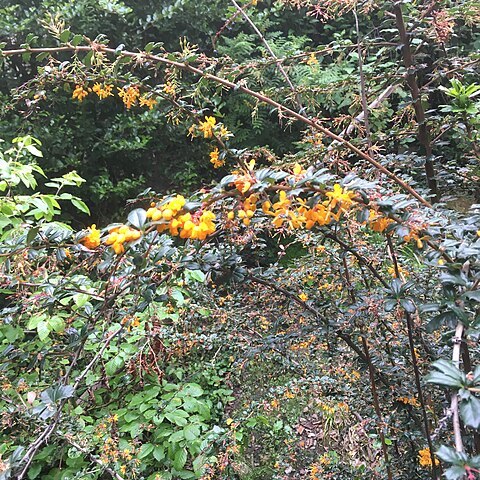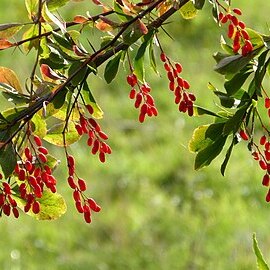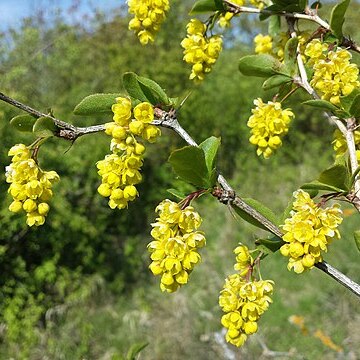Small, often profusely branched shrubs, occasionally armed with 1-to many-pronged barbs. Leaves simple, often crowded toward the apex of spur branches, membranaceous to coriaceous, deciduous or evergreen, sessile or with a short alate petiole, entire, revolute, or spinose-serrulate, subenervate or with obvious open or reticulate venation, often pruinose and papillose below. Flowers usually yellowish, subglobose, subsessile to long-pedicellate, usually 1-or 2-bracteolate, solitary, fascicled, umbellate, racemose or paniculate, the inflorescence often pedunculate, bracteate; sepals in 2-3 whorls of 3, the outer usually shorter and narrower, the inner usually obtuse, oblong to orbicular, as long as or longer than the petals, eglandular; petals usually in 2 whorls of 3, emarginate or rounded, often un-guiculate, usually with a basal pair of glands; stamens hypogynous, antepetalous, the anthers bilocular, valvate, the filaments occasionally subapically dentate, apically truncate or apiculate; ovary 1-to 15-ovulate, the stigma capitate, sessile or provided with a prominent style. Berries ellipsoid to globose, red, purple or black, often pruinose, juicy or rather dry, 1-to few-seeded, the seeds yellowish or cyanic.
Shrubs or small trees, evergreen or deciduous, inner bark and wood yellow. Leaves alternate, simple or pinnate, often with some leaves reduced to spines; in species with modified leaves (spines) the normal leaves in fascicles on short axillary spurs, the modified leaves usually as tripartite spines on long shoots. Inflorescence usually terminal on lateral shoots, variously racemose, fascicled or flowers solitary. Perianth yellow: sepal-like whorl 6, subtended by 2 or 3 bracts; petal-like whorl 6, often smaller than sepal-like whorl, each with 2 nectary-glands at base. Stamens 6, irritable when touched; anthers 2-valved. Ovary with 1-many ovules; stigma sessile or on short style. Fruit red, purple-red, pruinose or black, 1–several-seeded.
Shrubs, evergreen or deciduous. Branches glabrous or tomentose, spinose or not; spines simple or usually 3-5-fid. Leaves on short shoots, simple, alternate, usually petiolate. Inflorescences solitary or fascicled flowers, racemes, umbels, or panicles. Flowers 3-merous; bracteoles usually 3, caducous, scalelike. Sepals 6, rarely 3 or 9, yellow. Petals 6, yellow, bases nectariferous. Stamens opposite petals; anthers dehiscing by valves; pollen grains subspheroidal, exine reticulate. Ovary symmetrically club-shaped; ovules 1-12, rarely to 15, subbasal; styles very short. Fruit a berry, usually red, dark red, or black, globose, ellipsoid, oblong, ovoid, or obovoid. Seeds 1-10, tan to red-brown or black; aril absent. 2n = 14.
Evergreen or deciduous shrubs or subshrubs. Branches usually with simple or compound spines, which subtend short shoots bearing the leaves and flowers. Leaves in fascicles or whorls, sessile or shortly petiolate, simple or with 2 vestigial leaflets at the base; blade toothed or entire. Flowers solitary or in fascicles, umbels, racemes or panicles. Sepals in (1–)2–3(–4) series or whorls, petaloid, usually with 1–2(–3) smaller bracteoles below. Petals (5–)6, shorter or longer than the sepals, with 2 glands near the base. Stamens 6; filaments ± dentate at the apex, the connectives sometimes produced; anthers opening by valves. Ovary with 1–12(–15) basal ascending ovules. Fruit a berry.
Evergreen or deciduous shrubs, sometimes small subshrubs, usually glabrous or nearly so; wood yellow. Lvs on short or spur shoots simple, often with spiny margins; lvs on long shoots usually modified to form (1)-3-(5)-partite spines. Fls solitary, or in fascicles, racemes (sometimes pseudo-umbellate) or panicles, bracteate, axillary. Perianth segments 12 or 15, consisting of 6 or 9 sepals and 6 petals, imbricate, pale yellow to orange; innermost petals with nectariferous glands at base. Stamens 6, usually sensitive to touch; stigma sessile or on short style. Berry red or black, often with glaucous bloom, (1)-2-(several)-seeded.
Sep 6, biseriate, petaloid, subtended by 2 or 3 small bracts; pet 6, biseriate, usually smaller than the sep and each with 2 basal glands; stamens 6; ovary with 1–few ovules; fr a berry; spiny shrubs; primary lvs of the shoot modified into simple or often trifid spines, bearing axillary fascicles of small foliage lvs; fls yellow, in racemes, or contracted into umbel-like clusters, or solitary; fr in ours red. 600, widespread.
Leaves apparently simple but (in our species at least) derived from 3-foliolate leaves, the side leaflets represented by vestigial leaflets and the terminal leaflet articulated at the base.
Evergreen or deciduous shrubs; branches with usually 3-partite spines and short axillary shoots bearing the leaves.
Petals 6, free, imbricate, in two series, similar to the sepals but biglandular near the base.
Flowers in panicles, racemes, fascicles or solitary, yellowish or orange.
Sepals c. 9, petaloid, free, imbricate, the outer smaller than the inner.
Stamens 6, free; anthers opening by two valves.
Ovules few, basal, erect.
Stipules absent.
Fruit a berry.



